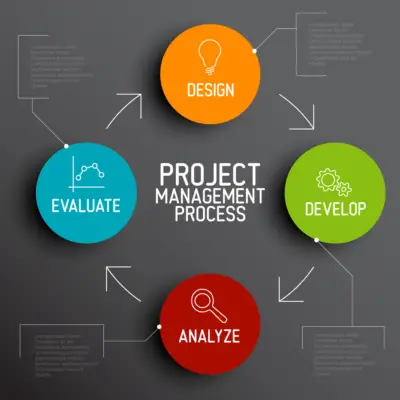In an era of rapid business transformation, the art and science of project and program management have never been more crucial. This article aims to debunk the differences between these two complementary disciplines and establish their inherent ties.
We start by defining and delving into program management, its strategic significance, and the critical responsibilities that program managers shoulder.
This is followed by exploring the essence and detailed understanding of project management, its impact on achieving specific goals, and the role of project managers.
Systems and structures surely appear complex on the surface, but with a systematic breakdown, we can uncover a comprehensive understanding of these management domains.
Understanding Program Management
Strategic vision is the compass guiding each business on its path to success. It is the North Star in a sea of tumultuous market conditions, shifting trends, and cutthroat competition. Yet, for all its importance, a strategic vision is nothing more than ethereal words unless effectively implemented through efficient program management.
Imagine a colossal, beautifully constructed ship equipped with the most advanced technology and designed to withstand the roughest storms.
Unfortunately, without a competent captain and crew, this magnificent vessel is merely a mass of wood and metal, helpless in the face of the sea’s caprices. The ship here is akin to a strategic vision, and the captain and his or her crew represent program management.
When guided by a strategic vision, program management ensures synchronicity between various projects, aligning them with an organization’s core objectives.
Effective program management keeps the ‘Big Picture’ in sight while ensuring the nitty-gritty details of each individual project are taken care of.
It enables translating the strategic vision into tangible achievements, helps cut through distractions, and provides a clear line of sight to specific, measurable goals.
One cannot overstate the importance of flexibility in program management. As market trends ebb and flow, program management must be adept at steering the strategic vision in these fluctuating tides while maintaining the course toward the ultimate objective. A rigid, too-structured approach won’t cut it in today’s dynamic business environment. Agility is key.
Furthermore, communication plays an indispensable role here. In this interconnected, digital world, there’s immense value in clear, consistent, and transparent communication. Stakeholders must understand a strategic vision’s ‘Why,’ ‘What,’ and ‘How.’ They need to be on board with the program management efforts.
Lastly, and most importantly, program management is not just about executing projects. It’s also about people. A proficient program manager nurtures high-performing teams, fosters collaboration, and encourages creativity.
Effective program management therefore does not merely ensure ‘work done.’ It cherishes and harnesses human capital, instils a sense of purpose, and creates leaders who will steer the organization toward success.
Strategic vision might be the starting point, the inspirational goal illuminating the somewhat opaque path toward success, but without effective program management, it remains just that – a mere vision.
Consequently, mastering program management ensures this strategic vision is realized into fruit-bearing actions and successes.

Unpacking Project Management
Dissecting Project Management vs Program Management: A Detailed Analysis
Delving into the corporate labyrinth, we peel back the complexity surrounding project management and program management, two core concepts that often get intertwined, blurring the delicate nuances underlying their differences.
Project management operates tactically, seeking short-term objectives with specific, quantifiable outcomes. Akin to checkmate in the game of chess, it’s all about the precise execution of premeditated steps, leading to a definitive conclusion.
The beauty of project management cynosure lies in its finite nature, allowing for a constant cycle of closure and accomplishment, feeding the momentum of the enterprise with smaller yet significant victories.
On the contrary, program management sails the broader, strategic seascape, synergizing multiple projects to achieve larger, overarching organizational goals.
Program management steers the ship through unknown waters, embracing uncertainty and harnessing new opportunities. It embraces change as a catalyst, an ingredient essential for corporate evolution.
The interplay between project management’s tactical approach and program management’s strategic focus forms the backbone of corporate success.
Consider it as the intertwining gears in the grand machinery of a thriving business; one piece isolated fails to capture the essence of the whole picture.
Project management relies heavily on the robustness of project management tools, software, and methodologies. These platforms provide the scaffolding that supports various activities, from schedule management, resource allocation, and risk management to monitoring the project’s progress in real-time.
The granular control endowed by project management enables an enterprise to keep a finger on the pulse, swiftly pivoting when necessary and delivering meticulously charted outcomes.
On the flip side, program management revolves around buffering the impact of multifaceted business dynamics on individual projects.
Program management ensures alignment with overarching goals by unifying various projects under a common umbrella, maintaining a steady course amidst shifting tides.
Project managers are the field generals, embroiled in the thick of the action, focusing on day-to-day tasks while juggling diverse elements such as lead times, deliverables, and milestones.
They implement processes meticulously, tracking performance and rectifying deviations promptly.
Program managers, in contrast, are the admirals, steering the fleet by mapping the broader strategy, synthesizing elements of the vast project portfolio, and fostering cohesion within diverse teams.
They’re the intermediaries, bridging gaps between executive vision and ground reality, ensuring the fruitful maturation of the corporate strategy.
Understanding these distinctions is critical for enterprises aiming to implement a hybrid approach that optimally leverages the tactical robustness of project management with the strategy formulation power of program management.
The harmony between the two lays the foundation for businesses to thrive, evolving into frontrunners in today’s hyper-competitive market landscapes.
Igniting this operational dynamo propels businesses to host a superior competitive edge, outshining rivals and etching lasting imprints in the annals of corporate excellence.

Distinctive Aspects of Program and Project Management
First and foremost, program management gravitates towards the long game, harmonizing multiple projects with the enterprise’s higher aims and premeditated goals.
This holistic approach often covers a broad landscape of initiatives, emulating an orchestra conductor adeptly guiding various sections to produce a harmonized symphony.
The conductor, akin to the program manager, does not participate in playing each instrument. Rather, they ensure that each section produces its part timely and excellently, enabling the production of a unified, compelling performance.
Project management, on the other hand, exemplifies the acute focus on a singular scheme, represented tightly by defined deliverables, budgetary constraints, and a specific timeline.
The project manager is akin to a virtuoso musician – proficient not in coordinating the whole orchestra but in playing their own designated instrument with supreme craft and precision, contributing towards the resulting symphony on a micro-level.
The key managerial differences between the two also demand mention, given that soft skills play an instrumental role in contributing to the divergence.
Like a skilled tactician, a project manager needs to be efficient at planning and executing, with incredible attention to detail and acute problem-solving abilities.
Meanwhile, the program manager, akin to a strategist, must demonstrate a broader spectrum of competencies, including leadership, vision, and the ability to foster cooperative relationships amongst diverse teams and stakeholders.
Toying with complexity is another key differentiator. As a general rule, program management encompasses a higher degree of intricacy, given the need to simultaneously manage multiple interrelated projects and align them to the broader strategic objectives of an organization.
This dynamic landscape necessitates stronger strategic foresight, superior steering skills, and more inclusive controls to monitor the interdependence of various projects and their respective outcomes.
The inherent risks associated with projects and programs also differ. Projects, owing to their focused purview, predominantly confront operational or execution-related risks.
With its broader purview, program management must grapple with strategic and organizational risks involving higher stakes and consequently requiring comprehensive risk management strategies.
To encapsulate, an organization’s prosperity may depend on the well-tuned interplay of expert program management setting the strategic tempo and proficient project management executing the carefully planned chords.
Recognizing their inherent divergences is the stepping stone towards harnessing the potential of both, in harmony, towards achieving resonant organizational success.
The reality of the volatile and competitive business landscape requires enterprises to tactfully weave this pluralistic approach into their management threads to stay resilient and continue thriving.

Interplay between Program and Project Management
At the juncture of program and project management, the true symbiotic magic unfolds for a business. Picture a master conductor leading an orchestra.
Each individual instrument plays its role, yet the true beauty of the music arises from the harmonious blend of all the instruments. Such is the dance between program and project management.
While the two possess distinct characteristics and functions, their seamless integration truly empowers a business to reach its strategic vision.
Enter the Synergy Zone, where the fluid transition between high-level strategy and granular tactics happens. Visualize a continuously looping Möbius strip.
Program management, the keeper of strategic focus, shapes one side of the loop. It embodies the broader perspective, offering navigation towards long-term objectives and ensuring every component project aligns perfectly with the overall objective.
On the other side of this loop, project management plays the implementer role, focusing on short-term tasks’ execution.
It molds the treble clef to the program management’s bass, laying the groundwork and taking care of the specifics. It’s where the program’s vision is translated into daily tasks and milestones to meet the immediate objectives and lay the foundation for long-term goals.
The real magic, however, manifests in the interaction and coordination between program and project management. To maintain the rhythm within this dance, businesses aspiring for success must hone their ability to embrace and effectively manage this interaction.
Therein lies the creation of a harmonized business ecosystem, fostering operational excellence, nurturing productive relationships, and encouraging innovative problem-solving.
Utilizing the advantages of both management styles allows an enterprise to break down siloed operations, enabling cross-functional collaboration and encouraging knowledge sharing.
The pivotal point between program and project management is the golden ticket to orchestrating the symphony of strategic and operational harmonization.
This isn’t merely a theoretical approach either. Businesses far and wide, from start-ups testing the waters to blue-chip corporations steering industry direction, validate the efficacy of this synergy through their impressive performances.
In accelerating digitization and ever-evolving market scenarios, mastering the magic between program and project management is not just the key to success but survival.
Recall, though, we operate in a dynamic business environment. The interplay between program and project management is not a static entity. As in any magic trick, the beauty lies in the constant fluidity.
Agility and flexibility must remain the primary components in the management toolbox. The secret to true synergy lies in recognizing the intricate ballet of program and project management and using that to keep pace with the market, ensuring you’re always several steps ahead.
One final note – don’t underestimate the allure of embracing innovation in your management approach. The fusion of program and project management can catalyze transformative change, stimulating creativity and fostering a culture of constant learning.
Undeniably, the world is changing rapidly – and those who master the magic of synergy between project and program management shall lead the dance.
After all, wouldn’t you prefer to be the conductor rather than just another instrument in the orchestra? Embrace this synergy, and let your business performance create a melody that resonates far and wide, heralding your prowess in harmonizing the dichotomies of management.

Conclusion
Last but not least, the section on the harmonious interplay between program and project management will pave pathways toward more efficient outcomes.
After understanding the definitive characteristics that distinguish these two management concepts, knowing their symbiotic relationship would advance one’s appreciation of their importance.
Comprehending the dynamics between program and project managers is crucial in achieving transformative results. Measures like effective communication, fruitful collaboration, and congruency in methodologies are underscored.
Through this comprehensive analysis, the outline will make each of us more informed, adept, and ready to tackle the complexities of contemporary business ecosystems.

Chris Ekai is a Risk Management expert with over 10 years of experience in the field. He has a Master’s(MSc) degree in Risk Management from University of Portsmouth and is a CPA and Finance professional. He currently works as a Content Manager at Risk Publishing, writing about Enterprise Risk Management, Business Continuity Management and Project Management.

